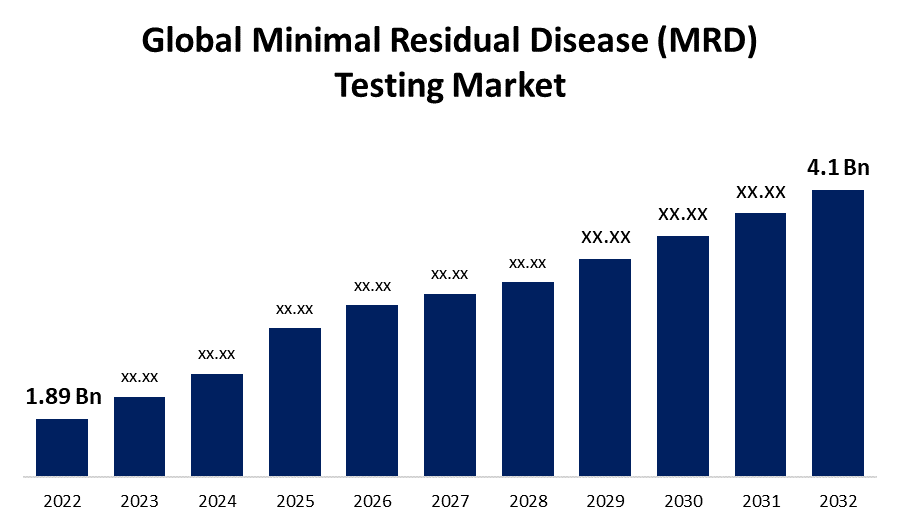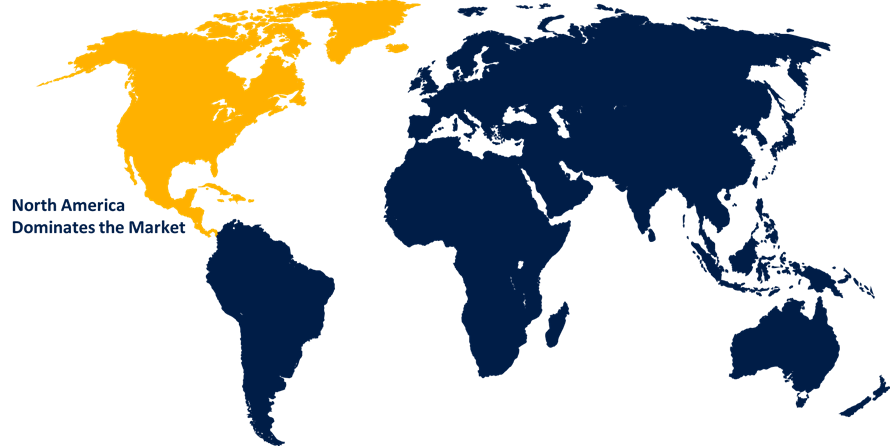Global Minimal Residual Disease (MRD) Testing Market Size, Share, and COVID-19 Impact Analysis, By Technology (Flow-cytometry, Polymerase Chain Reaction {PCR}, Next Generation Sequencing {NGS}), By Test Type (DNA-based Test, RNA-based Test, Immunological Test), By Application (Lymphoma, Leukemia, Solid Tumors), By End Use (Hospitals, Specialty Clinics, Diagnostic Laboratories, Research & Academic Institutes), By Region (North America, Europe, Asia-Pacific, Latin America, Middle East, and Africa), Analysis and Forecast 2022 – 2032
Industry: HealthcareGlobal Minimal Residual Disease (MRD) Testing Market Insights Forecasts to 2032
- The Global Minimal Residual Disease Testing Market Size was valued at USD 1.89 Billion in 2022.
- The Market Size is Growing at a CAGR of 8.05% from 2022 to 2032.
- The Worldwide Minimal Residual Disease Testing Market size is expected to reach USD 4.1 Billion by 2032.
- Asia Pacific is expected To Grow the fastest during the forecast period.

Get more details on this report -
The Global Minimal Residual Disease Testing Market Size is expected to reach USD 4.1 Billion by 2032, at a CAGR of 8.05% during the forecast period 2022 to 2032.
Market Overview
The global minimum residual disease (MRD) testing market refers to the market for diagnostic tests used to detect the existence of cancer cells in patients who have completed therapy. MRD testing is a very sensitive and specific technology capable of detecting minute numbers of cancer cells that may persist in a patient's body after therapy. The MRD testing market comprises goods and services such as assays, flow cytometers, and other testing equipment, as well as associated services such as sample preparation and analysis. The market serves healthcare practitioners, research institutions, and pharmaceutical businesses that employ MRD testing for illness monitoring, therapy selection, and clinical trial outcomes. In addition, Advances in minimal residual disease diagnostic technology lead to improvements in cancer treatment techniques. Furthermore, these minimum residual illness tests are specifically developed to assess treatment success, assist clinicians in confirming and monitoring remissions, and maybe detect an early recurrence of cancer. Flow cytometry, polymerase chain reaction (PCR), and next-generation sequencing (NGS), among other procedures, are the most commonly employed to evaluate minimum residual illness, according to the Leukemia & Lymphoma Society.
Report Coverage
This research report categorizes the global minimal residual disease testing market based on various segments and regions and forecasts revenue growth and analyses trends in each submarket. The report analyses the key growth drivers, opportunities, and challenges influencing the global minimal residual disease testing market. Recent market developments and competitive strategies such as expansion, product launch, and development, partnership, merger, and acquisition have been included to draw the competitive landscape in the market. The report strategically identifies and profiles the key market players and analyses their core competencies in each sub-segment of the global minimal residual disease testing market. Technological innovation and advancement will further optimize the performance of the product, enabling it to acquire a wider range of applications in the downstream market.
Global Minimal Residual Disease (MRD) Testing Market Report Coverage
| Report Coverage | Details |
|---|---|
| Base Year: | 2022 |
| Market Size in 2022: | USD 1.89 Billion |
| Forecast Period: | 2022-2032 |
| Forecast Period CAGR 2022-2032 : | 8.05% |
| 2032 Value Projection: | USD 4.1 Billion |
| Historical Data for: | 2018-2021 |
| No. of Pages: | 200 |
| Tables, Charts & Figures: | 110 |
| Segments covered: | By Technology, By Test Type, By Application, By End Use, By Region, and COVID-19 Impact Analysis. |
| Companies covered:: | Exact Sciences Corporation, GRAIL, LLC, Veracyte, Inc., Natera, Inc., Guardant Health, F. Hoffmann-La Roche Ltd, FOUNDATION MEDICINE, INC., QIAGEN, mdxhealth, Bio-Techne, and Other Key Venders. |
| Pitfalls & Challenges: | COVID-19 Empact, Challenge, Future, Growth, & Analysis |
Get more details on this report -
Driving Factors
Global cancer incidence has grown significantly and is likely to have a considerable influence on market growth for therapies for low residual sickness throughout the forecast period. Cancer patients receiving cancer therapy are expected to boost the growth of the global minimum residual sickness market during the forecast period. Due to the challenges of PCR, FISH, and flow cytometry in enumerating 1 in 100,000 cells, a shift in the patient's focus toward little residual illness is expected. Patients benefit from improved treatment accuracy as a consequence of the employment of cutting-edge technologies. These variables may have an impact on the global market. Furthermore, the development and application of next-generation sequencing (NGS) technologies, technical advancements in cloud computing and data integration, and the availability of a technologically improved framework for healthcare research are all propelling the market. In addition, the development of genome mapping initiatives and the improved regulatory and reimbursement environment for NGS-based diagnostic tests boosts the minimum residual disease market growth throughout the forecast period.
Restraining Factors
MRD tests, like other diagnostic and therapy methods, are subject to severe and complex regulations. Depending on the sort of test employed, various questions about its efficacy and appropriateness exist. Multiparameter flow cytometry studies, for example, might be difficult to interpret and may miss some cytogenetic features. As a result, the combination of strict standards and MRD test limits restrict the industry's development and improvement.
Market Segmentation
- In 2022, the flow-cytometry segment is influencing the market with the largest market share during the forecast period.
On the basis of technology, the global minimal residual disease testing market is bifurcated into flow-cytometry, polymerase chain reaction {PCR}, and next-generation sequencing {NGS}. Among these segments, the flow-cytometry segment is dominating the market with the largest revenue share during the forecast period. This can be attributed to flow cytometry's great sensitivity and extensive application in MRD testing. Flow cytometry is used to examine individual cells to see if certain protein markers are present on the cell surface. A fresh bone marrow sample is required for accurate findings. The bone marrow sample is treated with special antibodies that only attach to cells that contain a certain protein on them. Flow cytometry may detect one cancer cell out of 10,000 to 100,000 healthy bone marrow cells, depending on the setup. The findings may be available in less than a day.
- In 2022, the DNA-based Test segment is dominating the largest market share over the forecast period.
Based on the test type, the global minimal residual disease testing market is segmented into different categories such as DNA-based Tests, RNA-based Tests, and Immunological Tests. Among these segments, the DNA-based Test segment is dominating the market during the forecast period due to their high level of specificity and sensitivity for detecting cancer cells. However, due to improvements in technologies such as next-generation sequencing (NGS) and digital PCR, the RNA-based testing sector was predicted to increase at the quickest CAGR over the projection period.
- In 2022, the lymphoma segment is dominating the market with the largest market share during the forecast period.
Based on application, the global minimal residual disease testing market is segmented into lymphoma, leukemia, and solid tumors. Among these segments, the lymphoma segment is expected to have significant development potential over the analysis period due to the rising prevalence of lymphoma is expected to boost the market in the coming years. According to the American Cancer Society, about 90,300 persons in the United States will be diagnosed with lymphoma by 2021. This illness load is predicted to increase with each passing year. Swelling lymph nodes in the neck, armpits, or groin are frequent signs of lymphoma.
Regional Segment Analysis of the Minimal Residual Disease Testing market
- North America (U.S., Canada, Mexico)
- Europe (Germany, France, U.K., Italy, Spain, Rest of Europe)
- Asia-Pacific (China, Japan, India, Rest of APAC)
- South America (Brazil and the Rest of South America)
- The Middle East and Africa (UAE, South Africa, Rest of MEA)
North America influenced the market with the largest market share over the forecast period

Get more details on this report -
North America is influencing significant market growth during the forecast period owing to the It is ascribed to preventive efforts implemented by governments to halt illness development. Because of the great knowledge of the benefits of screening among patients and clinicians, the United States and Canada are the two biggest markets for cancer screening in North America. Furthermore, various projects are being launched in the region to provide MRD testing. For example, Natera secured a National MRD testing contract with the U.S. Department of Veterans Affairs (VA) National Precision Oncology Program in November 2022 for delivering MRD and monitoring services using the company's Signetera MRD test.
Asia Pacific is expected to experience high revenue market growth during the forecast period due to increased investment in screening and the availability of supporting reimbursement policies, Japan is likely the biggest market in the Asia Pacific. In addition, the region has a high frequency of hematological malignancies, necessitating MRD testing. The market's key players are focused on research to produce unique tests. Furthermore, the growing requirement for cancer surveillance and the development of innovative MRD technologies is fueling the region's market expansion.
Competitive Analysis
The report offers the appropriate analysis of the key organizations/companies involved within the global minimal residual disease testing market along with a comparative evaluation primarily based on their product offering, business overviews, geographic presence, enterprise strategies, segment market share, and SWOT analysis. The report also provides an elaborative analysis focusing on the current news and developments of the companies, which includes product development, innovations, joint ventures, partnerships, mergers & acquisitions, strategic alliances, and others. This allows for the evaluation of the overall competition within the market.
List of Key Companies
- Exact Sciences Corporation
- GRAIL, LLC
- Veracyte, Inc.
- Natera, Inc.
- Guardant Health
- F. Hoffmann-La Roche Ltd
- FOUNDATION MEDICINE, INC.
- QIAGEN
- mdxhealth
- Bio-Techne
Key Target Audience
- Market Players
- Investors
- End-users
- Government Authorities
- Consulting And Research Firm
- Venture capitalists
- Value-Added Resellers (VARs)
Recent Development
- In August 2022, The Digital LightCycler System, Roche's first digital polymerase chain reaction (PCR) system, was introduced. This next-generation device diagnoses illnesses and is designed to correctly quantify minuscule quantities of particular DNA and RNA targets that current PCR techniques cannot detect.
- In February 2022, Personalis announced a strategic collaboration with the Moores Cancer Center at UC San Diego Health, a National Cancer Institute-designated Comprehensive Cancer Center, to support clinical diagnostic testing in patients with advanced solid tumors and hematological malignancies. The partnership will involve research investigations for high-sensitivity minimum residual disease (MRD) identification and cancer recurrence detection using a recently announced liquid biopsy test.
Market Segment
This study forecasts revenue at global, regional, and country levels from 2022 to 2032. Spherical Insights has segmented the Global Minimal Residual Disease Testing Market based on the below-mentioned segments:
Global Minimal Residual Disease Testing Market, By Technology
- Flow-cytometry
- Polymerase Chain Reaction {PCR}
- Next Generation Sequencing {NGS}
Global Minimal Residual Disease Testing Market, By Test Type
- DNA-based Test
- RNA-based Test
- Immunological Test
Global Minimal Residual Disease Testing Market, By Application
- Lymphoma
- Leukemia
- Solid Tumors
Global Minimal Residual Disease Testing Market, By End Use
- Hospitals
- Specialty Clinics
- Diagnostic Laboratories
- Research & Academic Institutes
Minimal Residual Disease Testing Market, By Regional Analysis
- North America
- US
- Canada
- Mexico
- Europe
- Germany
- Uk
- France
- Italy
- Spain
- Russia
- Rest of Europe
- Asia Pacific
- China
- Japan
- India
- South Korea
- Australia
- Rest of Asia Pacific
- South America
- Brazil
- Argentina
- Rest of South America
- Middle East & Africa
- UAE
- Saudi Arabia
- Qatar
- South Africa
- Rest of the Middle East & Africa
Need help to buy this report?